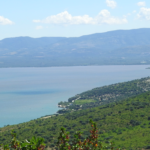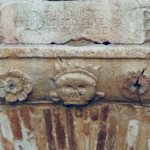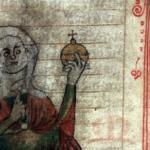
The Lost Cities of Ancient Apulia – South-East Italy

When we read stories of ancient pre-Roman Italy, often the point of view we absorb is that of the Greek city-states of southern Italy, or of their later Roman neighbours. Virtually no written material except the Greek or Roman has survived the ancient period. This is despite writing having spread to their neighbours. To the extent that other peoples of ancient Italy appear in the written record, they do so as “decoration” in Roman and Greek centred stories. The peoples of Ancient Apulia are a case in point.
The Greek and Romans often described the people around them as “tribal” and led by kings or chiefs. From the seventeenth to the nineteenth centuries, during the European colonisation of the world, Europeans had a similar view of the world – dividing it between “civilised” and “tribal” or uncivilised. It is an example of how ancient thinking re-emerged as the European empire builders drew parallels between themselves and the colonial and imperial projects of the ancient world. Indeed, they often consciously claimed to be the heirs of that ancient culture.
Recent decades of archaeology of southern Italy however tells a much more complex story of the realities of the ancient world. Southern Italy was a major site of Greek colonisation during the 8th and 7th centuries BC. Cities such as Naples, Syracuse and Taranto are among the more well-known of the string of cities that dotted the coast of southern Italy and Sicily. The influence of Greek culture was so strong that Romans later called the area “Magna Graecia”: Great Greece.
However archaeologists have established that the ancient Greek cities of Italy, although culturally Greek, were created by a mixed population of both Greek settlers and local populations. Nor were the Greek cities surrounded by a “barbarian” hinterland. The story is the same across much of Italy and Europe, although this article focuses on the Apulia region.
Ancient Apulia in South-East Italy has a rich archaeological record stretching back to the Neolithic period. It is generally believed that from about 1000 BC people from Illyria, on the opposite coast of the Adriatic, settled the area. They spoke languages different both from the Italic languages spoken elsewhere in Italy and the Greek language of the coastal cities.
Later the Greeks and Romans called these people Iapygians and divided them into Daunians, Peucetians and Messapians spread north to south along Apulia. The ancient Roman geographer Strabo, however suggests that they called themselves “Apuli”, “Calabri” and “Salentini”. The picture from archaeology doesn’t necessarily support simple “ethnic” divisions and shows a region with its own culture and “civilisation” that was changing in parallel with the Greek speaking cities around them.
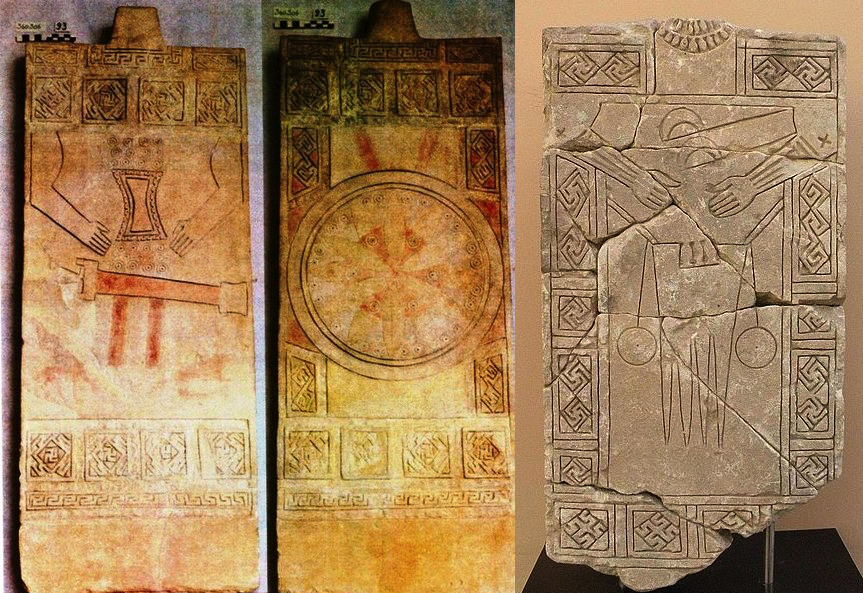
Among the most informative archaeological finds that bring parts of the story of this ancient culture to life are flat stone carvings of stylised male and female figures (stele) that date to the eighth century BC which are found in northern Puglia. The designs show “male” warriors bearing shields and swords and “female” figures who wear distinctive aprons and whose arms are tattooed. Round objects hanging from their belts are interpreted as poppy pods and the dress could be an indication of a religious role played by the women. Whether the stele represented deceased people or mythical figures is debated. Sometimes the decorations on the carvings convey stories of travellers, show domestic scenes such as weaving, or religious processions, or riders standing on the back of horses in what look like equestrian contests, chariots and other figures.
Camilla Norman notes the similarity of the female figures (which are the most numerous) to traditional costume in Albania and Thrace (consistent with the Illyrian origin stories told by the Greeks and Romans). Both the apron styles and the tattooing of fore arms of women were traditional practices in these areas.

As culture continued to evolve in Apulia it took on more Greek characteristics. Cities (sometimes as long established as the 7th century BC) emerged. Some of the elite architecture began to take on Greek styles. Older local ceramic styles were replaced with Greek style pottery of the classical era. The area in fact became a major centre for the production and export of “Attic” style pottery to the Greek world.
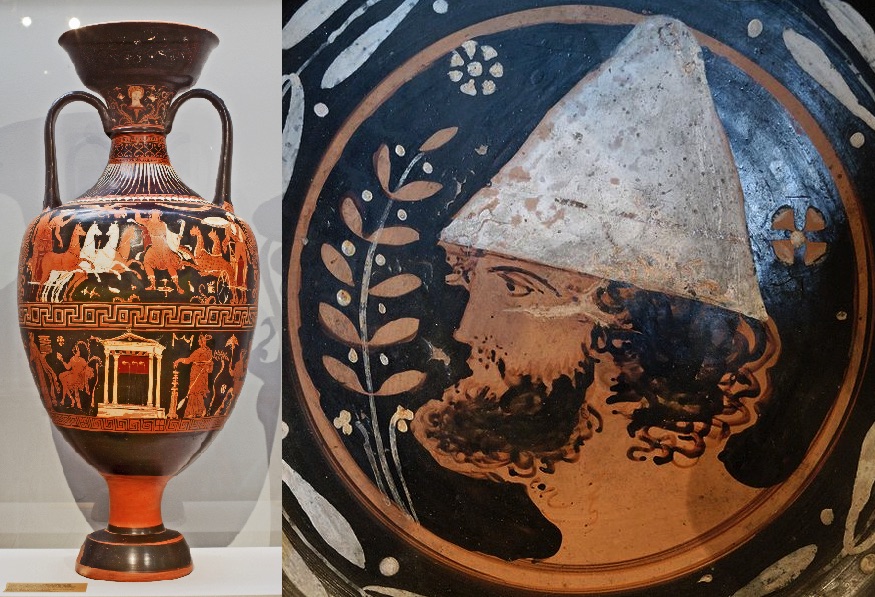
Hellenization of Ancient Apulia and the Second Punic War
By the third century, a number of city-states evolved in these now increasingly Hellenized areas. The coins that the cities produced is part of the evidence of their development. Cities such as Arpi, Teanum. Apulum, Lucera, Bitonto, Canusia, Salapia and Venusa all produced their own coinage on Greek (and later) Roman models. Arpi was one of the largest of these cities. It was surrounded by a 13 kilometre long 2 metre high earthen wall and ditch. Later this wall was topped with a one metre high stone wall. Teanum to its north was similarly large.
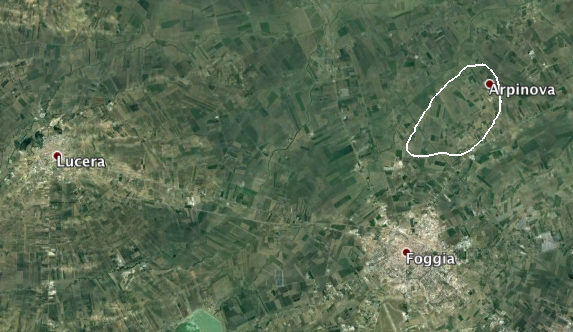
These emerging city-states were increasingly drawn into conflicts of the Greek and Roman world. We learn something about the size of the populations from the armies they sent as allies of their neighbours. In the 3rd century, Rome’s Apulian allies sent 50,000 foot and 16,000 cavalry to help Rome fight its Celtic enemies. For the second Punic War Polybius records the troops that various parts of Italy could supply to support the Romans. Iapygia and Messapia could contribute 50,000 foot and 6,000 cavalry. Such evidence and archeological surveys have led to lower estimates of around 145,000 people for the population of the Salento (i.e. the Messapians). Just one city in northern Apulia, Arpi, had a free population of around 30,000.
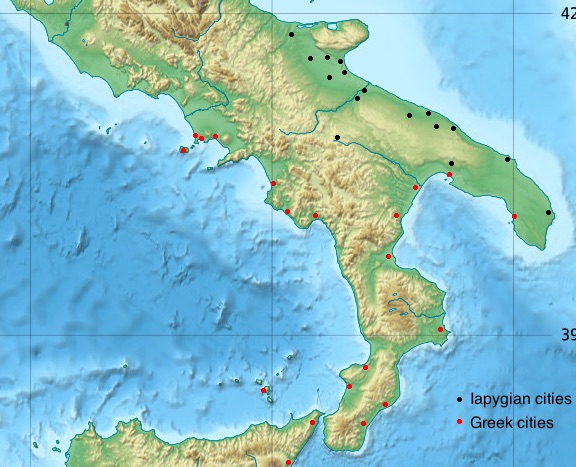
Both sides played a part in devastating Ancient Apulia during the Second Punic War. Rome’s greatest defeat at Hannibal’s hands at the Battle of Cannae occurred in Apulia itself.
It was a loss in which Rome’s allies shared, as they provided half of the forces at the battle. After this many of the cities of the region switched allegiance to Hannibal. When the Romans returned they reduced some of the cities of Apulia that had gone over to Hannibal. New Roman colonies were established in some places. Rome now controlled (effectively colonised) the economy of the region. Although the local culture did not entirely disappear, the future would be firmly Roman. The local language did not survive.
Images
Coin Collage – from Wikipedia creative commons images
- Coin from ancient Lucera
- Coin from Lucera 211-200 BC
- Coin of Teanum Apulum 250-225BC
- Coin from Canosa di Puglia 250 – 225 BC
- Coin from Venusia c. 260 BC
- Coin from Bitonto 275 – 225 BC
Male and Female Daunian Stelae from Wikipedia creative commons images
- Male Stele
- Female Stele 610-550 BC
Apulian pottery from Wikipedia creative commons images
- Apulian Amphora 350 BC
- Man wearing the pilos (conical hat). Tondo of an Apulian red-figure plate, third quarter of the 4th century BC.
Sources
Daunians, Peucetians and Messapians? Societies and Settlements in South-East Italy, Edward Herring in Ancient Italy : regions without boundaries edited by Guy Bradley, Elena Isayev and Corinna Riva
Kathryn Lomas, Cities, states and ethnic identity in southeast Italy in ed. Edward Herring and Kathryn Lomas, The Emergence of State identities in Italy in the first Millennium BC,
The Geography of Strabo Book VI, Chapter III
Camilla R. Norman, Iron Age Stelae of Daunia, 2013 PhD Dissertation, University of Sydney
Brunt PA. Italian manpower, 225 B.C. – A.D. 14. Oxford: Clarendon Press; 1971, p 45
Douwe Yntema, Polybius and the Field Survey Evidence from Apulia in People Land and Politics Demographic Developments and ed. Luuk de Light and Simon Northwood Transformation of Roman Italy 300 BC – AD 14, Leiden 2008, chapter
Michael P. Fronda, Between Rome and Carthage, New York : Cambridge University Press, 2010
